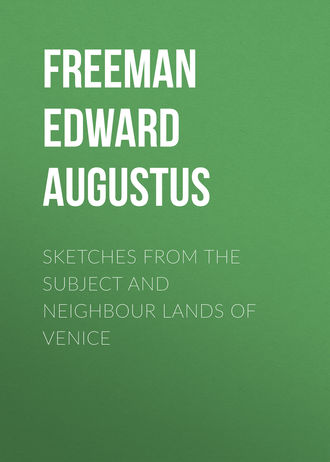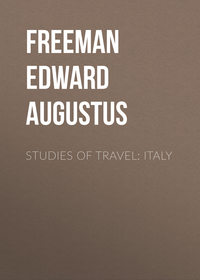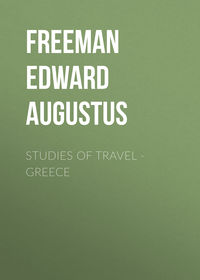 полная версия
полная версияSketches from the Subject and Neighbour Lands of Venice
When I was last at Spalato, a process was going on which always makes one tremble. The peristyle and the inside of the mausoleum were surrounded by scaffoldings. As for the mausoleum, it was perhaps a mistake ever to make it into a church; but, as it has been made into a church, the additions and changes which were needed for that purpose have become part of the history, and ought not to be meddled with. It must always have been nearly the smallest, and quite the darkest, metropolitan church in Christendom; but that it is so is part of the wonder of the place. And, if some of the details were restored in plaster at the time of a certain famous royal visit, it seems hardly worth while to knock them away, with the chance of knocking away some of the genuine stone along with them. That royal visit is commemorated in a tablet at the end of the peristyle, which professes great loyalty to a personage described as "Franciscus Primus, Austriæ Imperator et Dalmatiæ Rex." The man so labelled in Diocletian's own house had been the last successor to Diocletian's empire.
In the changes which are being made in the peristyle, it is said that this tablet was first taken down as being modern, and then set up again, because official loyalty overrode all considerations of what was old and what was new. But some care should be taken in removing what is modern in such a place as Spalato. It is very well to get rid of some mean excrescences; but, where the arches have been filled up by Venetian buildings of respectable work, it would seem to be a great mistake to open them, to say nothing of the chance that such opening may endanger the columns and arches themselves. Though built up, they are not so blocked as to hinder a full study of their details. Indeed the building up, both of the arches of the peristyle and of the heavier arches in the other parts of the palace, is really a part of the history which should be preserved. It marks the distinctive character of Spalato as the house which became a city.
That city, as it now stands, stretches, I need hardly say again, a long way beyond the bounds of the ancient house. Yet one cannot conceive Spalato without Diocletian's palace. It is something much more than the chief object and ornament of Spalato, as this or that building is the chief object and ornament of any other city. It is more than the castle or monastery round which a city has often grown. It is not merely that, but for the existence of the palace, the city would never have come into being; the palace still is the city in a sense in which we could hardly use those words of any other building elsewhere. Yet there are things to see at Spalato besides the palace. The museum is eminently a thing to see; but then it is within the palace, and moreover, though it is locally placed at Spalato, it belongs historically to Salona. There is a good deal of pretty Venetian work scattered up and down, both within the walls of Diocletian and without them. The piazza just outside the gate of iron, where the traveller will most likely seek his breakfast, his coffee, and his maraschino, would have some attractions in itself, if it did not lie just outside the gate of iron. The eye naturally turns to the gate, and to the little campanile perched on it; otherwise it might very fairly rest on the Venetian loggia, with its columns and their wide – yet not sprawling – pointed arches. It might rest none the less because the building so strongly suggests that class of English town-halls or market-houses of which I said something when speaking of Udine. The octagonal tower too, and the remains of the Venetian fortifications generally, are worth a glance. The difficulty is, in the home of Jovius, to give even a glance to anything but the works of Jovius.
The mausoleum, now the once metropolitan church, and the temple, now the baptistery, have both of them become churches by accident. Besides these, the first impression is that Spalato has little to show in the ecclesiastical line. And further examination will not take away that impression as to quantity, though it will modify it somewhat as to quality. The little desecrated church which in 1875 I saw just within the palace walls, embodied in military buildings, I could not find in 1881. I was told that it had been burned, and there certainly was a burned building thereabouts; but I did not feel quite sure that I had hit upon the right site, and whether the church that I was looking for might not still be there, imprisoned in some of the queer devices of Austrian occupation. But in 1881 I and my companion lighted by way of recompense on one most curious building which neither of us had seen in earlier visits. This is the little church of Saint Nicolas in the suburb on the slope of the hill. It is very small, of a rude kind of Byzantine type, with four of the very strangest columns I ever saw. Save that they have a mighty entasis, they really have more of an Egyptian cut than anything Greek, Roman, Gothic, or any of the forms to which Aryan eyes are used. The Franciscan church at the foot of the hill, with its cloister, would be worth a glance for its own sake; and it is worth much more than a glance on account of the precious sarcophagus which the cloister shelters. But this, like the objects in the museum, is an outlying fragment of Salona, to be talked of there. To the modern church on the other side of the city it would be only kindness to shut our eyes. But we cannot help looking at it; it aims at the style of the place, and clearly fancies itself to be Romanesque, if not Roman. We look at its tower, and we look back to the mighty campanile within the walls. Somehow the fourteenth century could adapt itself to the fourth; but the nineteenth cannot adapt itself to the fourteenth. Yet it is something for Spalato to say that it contains the noblest and the most ignoble of all towers that do profess and call themselves Romanesque.
Eitelberger has well hit off the character of the three chief Dalmatian cities in three pithy epithets. Zara is bureaukratisch; Spalato is bürgerlich; Ragusa is alt-aristokratisch. The burghers seem to make more progress than either the foreign officials or the native patricians. Both better quarters and better dinners can be had at Spalato in 1881 than were to be had there in 1875. In 1881 we can walk on shore, while in 1877 boats were needed. And in 1881 the railway – a wonder in Dalmatia – was ready to carry us to Salona or even to Sebenico, but not to Traü. On the other hand in some other respects, if not Spalato, at least its foreign rulers, seem to advance backwards, if they advance at all. Those who dwell under the shadow of Apostolic Majesty are used to the daily suppression of such newspapers as venture to proclaim inconvenient truths. At Spalato that Apostolic and constitutional power has gone a step further by suppressing the municipality. With us, when a Stewart king suppressed an ancient corporation, he at least set up another of a new Stewart fashion. But at Spalato the podestà– the potestas still lingers in Dalmatia, while in Italy only syndics are tolerated – and the other elders of the city seem to have become altogether things of the past, no less than Jovius and his Empire.
SALONA
1875 – 1877 – 1881The strictly classical student will perhaps be offended if any one, on reading the name at the head of this article, should ask him where the place is, and how its name is to be pronounced. Salona, he will answer, is in Dalmatia, and how can there be more than one way of sounding the omega in the second syllable? And so far he will be right. The Salona of which we speak is in Dalmatia, and, as its most usual Greek forms are Σαλῶνα and Σαλῶναι, there can be no doubt as to the rights of that particular omega. But those who have gone a little deeper into the geography of south-eastern Europe will know that, besides the Dalmatian Salona, there is another within the Greek kingdom, which has taken the place of the Lokrian Amphissa. As we write the names of the two, we make no difference between them, and we fear that most Englishmen will make as little difference in sounding the two names as in writing them. Yet, as Boughton in Northamptonshire and Boughton in Kent are, by those who have local knowledge, sounded in two different ways, so it is with the Lokrian and the Dalmatian Salona. Σάλωνα and Σαλῶνα differ to the eye; and, among those with whom Greek is a living tongue, they differ to the ear also. But it is not with the Lokrian Sálona, but with the Dalmatian Salóna, that we are here concerned. We need not disturb the feelings of the late Bishop Monk, whose one notion of accentual reading was that those who follow it must "make some strange false quantities." The classical purist may make the omega in the Dalmatian Salóna as long as he pleases. Only, if he pronounces the Lokrian Sálona in the same fashion, he will wound the ears of those to whom the chief notion of (so-called) quantitative reading is that those who follow it must make some strange false accents.
At Salona we are in one of the subject lands of Venice, but we cannot say that we are in one of her subject cities. For Salona, as a city, had passed away before the Serene Republic bore rule on these coasts, in truth before the Serene Republic was, while the lagoons still sheltered only those few settlers whom the minister of Theodoric likened to waterfowl on their nests. As a city, it passed away as few cities have passed away. Others indeed have perished more thoroughly; of some the very sites have been lost; but there is no city whose name survives which has left so little trace of what it was in the time of its greatness. For it is not like those cities whose very name and memory have perished, which are wholly ruined or buried, which have no modern representatives, or whose modern representatives bear wholly different names. Salona is still an existing name, marked on at least the local map; but, instead of the head of Dalmatia, one of the great cities of the Roman Empire, a city which was said to have reached half the size and population of the New Rome itself, we find only a few scattered houses, which hardly deserve the name of a village. By the side of modern Salona, modern Aquileia looks flourishing, and modern Forum Julii might pass for a great city. For Aquileia is not wholly dead as long as the patriarchal basilica still stands, if only to discharge the functions of a village church. But at Salona the traveller hardly notices whether there be any church in use or not. Of modern objects the one which is most likely to catch his eye is the building which at least proclaims, in the name of "Caffè Diocleziano," that Salona in her fall has not forgotten the man who commonly passes for her greatest son, who, according to some, was her second founder, and who, in any case, was her most renowned neighbour. By a strange piece of good luck, the citizen and sovereign of Salona who came back to spend his last days in his own land had reared at no great distance from her the house which, when Salona fell, stood ready to receive her inhabitants, and to take her place as a new city.
There is a marked difference between the position of the older and that of the newer city. Spalato stands indeed on a bay, but it is a bay which, in that region of channels and islands, may pass for the open sea. Salona lay at the innermost point of the deep gulf which bears her own name, the gulf which forms one side of the peninsula on which Spalato stands, and which is shielded from the main sea by the island of Bua. It is curious to compare the real geography with the way in which the land and sea are laid down in the Peutinger Table, where Bua seems nearer to the coast of Italy than it is to Salona. Sir Gardner Wilkinson appositely quotes the lines of Lucan: —
"Qua maris Hadriaci longas ferit unda Salonas,Et tepidum in molles Zephyros excurrit Iader."Longæ certainly well expresses the way in which the city must have spread itself along the mouth of the river, and the northern side of the bay. And, more than this, the idea of length must have been deeply impressed on Salona by the long walls which, as we shall presently see, yoked the city to something or other beyond her own immediate defences. Salona, like most of the older cities, was not at all like one of our square chesters which rose up at once out of some military necessity. The Dalmatian capital had grown up bit by bit, and its walls formed a circuit almost as irregular as that of Rome herself. The site was a striking one. As we set forth from the comparatively flourishing daughter to visit the fallen mother, the road from Spalato leads us over a slight hill, from the descent of which we look on the bay with its background of mountains, a view which brings before us two strongly contrasted sites of human habitation. In advance of the mountain range stands the stronghold of Clissa, so famous in later wars – a stronghold most tempting in a distant view, but utterly disappearing when we come near to it. The seat of the Uscocs has nothing to show but its site and an ugly fortress; yet the hill is well worth going up, for the site and the view from it, a most instructive geographical prospect over mainland, sea, and islands. We turn to our Imperial guide, and we find that Κλεῖσα was so called because it kept the key of the passage over the mountains. It was the Κλεισοῦρα , so called διὰ τὸ συγκλείειν τοὺς διερχομένους ἐκεῖθεν. He has to tell us how it was taken by invaders, whom he speaks of as the Slaves who were called Avars (Σλάβοι, οἱ καὶ Ἄβαροι καλούμενοι ). The ethnological confusion is like that of another self-styled Imperial personage, who thought that he could get at a Tartar by scratching a Russian. But in both cases the confusion is instructive, as pointing to the way in which Slavonic and Turanian nations were mixed up together, as allies and as enemies, in the history of these lands. Far below, on the bosom of the bay, a group of small islands are covered by a small village, which seems to float on the water, and which well deserves its name of Piccola Venezia. Between the height and the sea lay Salona, on a slight elevation gently sloping down to the water; here, as so often on the Dalmatian coast, it needs somewhat of an effort to believe that the water is the sea. To the right of the road, we see the ruins of the aqueduct which brought water to the house of Diocletian – an aqueduct lately repaired, and again set to discharge its ancient duties. Ancient fragments of one kind or another begin to line the road; an ancient bridge presently leads us across the main stream of the Giadro, Lucan's Iader, which we might rather have looked for at Zara. We mark to the right the marshy ground divided by the many channels of the river; we pass by a square castle with turreted corners, in which a mediæval archbishop tried to reproduce the wonder of his own city; and we at last find ourselves close by one of the gates of Salona, ready to begin our examination of the fallen city in due order.
The city distinctly consists of two parts. A large suburb has at some time or another been taken in within the walls of the city. This is plain, because part of a cross wall with a gate still remains, which must have divided the space contained within the outer walls into two. This wall runs in a direction which, without professing to be mathematically correct, we may call north and south. That is, it runs from the hills down towards the bay or the river. Now, which was the elder part of the two? that to the east or that to the west? In other words, which represents the præ-Roman city, and which represents its enlargement in Roman times? By putting the question in this shape, we do not mean to imply that any part of the existing walls is of earlier than Roman date. The Roman city would arise on the site of the earlier settlement, and, as it grew and as its circuit was found too narrow, it would itself be further enlarged. The cross wall with the gate in it must of course have been at some time external; it marks the extent of the city at the time when it was built; but in which way has the enlargement taken place? It used to be thought that the eastern, the most inland division, was the elder, and that the city was extended to the west. And it certainly at first sight looks in favour of this view that, in the extreme north-west corner, an amphitheatre has clearly been worked into the wall, exactly in the same way in which the Amphitheatrum Castrense at Rome is worked into the wall of Aurelian. How so keen an observer as Sir Gardner Wilkinson could have doubted about this building being an amphitheatre, still more how his doubts ended in his positively deciding that it was not, seems really wonderful. It has all the unmistakeable features of an amphitheatre, and we can only suppose that a good deal has been brought to light since Sir Gardner Wilkinson's visit, and that what is seen now was not so clearly to be seen then. As amphitheatres were commonly without the walls, this certainly looks as if the eastern part were the old city, and as if those who enlarged it to the west had made use of the amphitheatre in drawing out their new line of fortification, exactly as Aurelian in the like case made use of amphitheatre, aqueducts, anything that came conveniently in his way. But, on the other hand, Professor Glavinič, whom we have already referred to when speaking of Spalato, and whose keener observation has come usefully in the wake of the praiseworthy researches of Dr. Carrara, has pointed out with unanswerable force that the gate has two towers on its eastern side, showing that that side was external, and that therefore the western part must be the older and the eastern the addition. This is evidence which it is impossible to get over. Clearly then the space to the west of it was once the whole city, and the far greater space to the east once lay beyond the walls. The gate must have been a grand one; but unluckily its arches have perished. There was a central opening, along which the wheel-tracks may still be traced, and a passage for foot-passengers on each side. The large rectangular blocks of limestone of which it is built have been encrusted in a singular way with some natural formation, which might almost be mistaken either for plaster or for some peculiarity of the stone itself. In the northern wall of the eastern part is an inscription commemorating the building or repair of the wall in the time of the Antonines. This by itself would not be conclusive; for the wall might very well have been rebuilt in their day and the city might have been enlarged to the west in a still later time. But the position of the gate is decisive, and the position of the amphitheatre is a difficulty that can easily be got over. If, besides the great enlargement to the east, we also suppose an enlargement to the west which would take the amphitheatre within the city walls, this will be quite enough.
We may rule then that the Illyrian city, the earlier Roman city, stood to the west of the cross wall, and that it was enlarged at some time earlier than the reigns of the Antonines by taking in an eastern suburb larger than the original town. The walls of both parts may be traced through a large part of their extent. The outer gate to the east was flanked by octagonal towers, and both a square and an octagon tower may be traced near the north-east corner. But the most remarkable thing about the walls of Salona is that, besides the walls of the city itself, there are long walls, like those of Athens and Megara, reaching from the western side of the city for a mile and more nearly along the present road to Traü. They have not been traced to the end; but there can be no doubt that they were built to make long Salona yet longer by joining the town to some further point of the coast. Nothing is more natural; the water of the bay by Salona itself is very shallow; when the city became one of the great maritime stations of the world, it was an obvious undertaking to plant a dock at some point of the coast where the water was deeper. And to one who comes to Salona almost fresh from the hill-cities of central Italy, from the strongholds of Volscians, Hernicans, and Old-Latins, from Cora and Signia and Alatrium, it becomes matter of unfeigned surprise to find Dalmatian antiquaries speaking of these walls as "Cyclopean." The name "Cyclopean," though as old as Euripides, is as dangerous as "Pelasgian" or "Druid;" but, if it means anything, it must mean the first form of wall-building, the irregular stones heaped together, such as we see in the oldest work at Cora and Signia. Here we have nothing of the kind. The blocks are very large, and the outer surface is not smooth; but all of them are carefully cut to a rectangular shape, and they are laid with great regularity. There seems no kind of temptation to attribute them to any date earlier than the Roman conquest of Illyricum. The style of building is simply that which is made natural by the kind of stone. And the same kind of construction, though with smaller blocks, is that which prevails throughout the walls of Salona, except where later repairs have clearly been made. This has happened with the outer wall to the west, where some earlier fragments have even been built in. Otherwise, by far the greater part of the walls, towers, and gates of Salona, not forgetting a gate which has been made out in the long walls themselves, all belong to one general style of masonry.
Within the walls of Salona the general effect is somewhat strange. The city is pierced by the road from Spalato to Traü; in these later times it has been further pierced by the railway – strange object in Dalmatia, strangest of all at Salona – which starts from Spalato, but which does not find its way to Traü. The greater part of the space is still covered with vineyards and olive-trees; systematic digging would bring a vast deal to light; but a good deal positively has been made out already. The amphitheatre has been already spoken of; the road cuts through the theatre. But, as becomes the history of the city, the greater part of the discoveries belong to Christian times, to the days when the bishopric of Salona was a post great enough to be employed to break the fall of deposed emperors. But we may doubt whether the head church of Salona, the church which held the episcopal chair of Glycerius, has yet been brought to light.
Near the north-western corner of the eastern division of the city the foundation of a Christian baptistery has been uncovered. The site of the baptistery, according to all rule, must be near to the site of the great church of the city. Now the baptistery stands near the wall; is it fanciful to think that at Salona, as well as at Rome, it was not thought prudent in the earliest days of the establishment of Christianity to build churches in the more central and prominent parts of the city? The baptistery of Salona keeps – the great basilica must therefore have kept – under the shadow of the wall of the extended city, exactly as the Lateran basilica and baptistery do at Rome. Of the baptistery it is easy to study the plan, as the foundations and the bases of the columns, both of the building itself and the portico in front of it, are plainly to be seen. Many of their splendid capitals are preserved among the rich treasures of the museum at Spalato. These are of a Composite variety, in which the part of the volute is played by griffins, while the lower part of the capital is rich with foliage of a Byzantine type. West of the baptistery, but hardly placed in any relation to it, are the remains of a small church, which seems to have been a square, with columns to the east and an apse to the north. Whatever this building was, it surely can never have been the great church of Salona. That must have been a basilica of the first class; and we may hope that future diggings may bring that to light also. But outside the city to the north, successive diggings have made precious discoveries in the way of Christian burying-places and churches. Since the last researches have been made, it is perfectly clear that here, outside the walls, like the basilicas of the apostles at Rome, there stood a church of considerable size, that it had supplanted a smaller predecessor, and that it had another smaller neighbour hard by. It is now easy – but it is only very lately that it has become easy – to see nearly the whole outline of a church measuring – speaking roughly – about 120 feet long. It ranged therefore with the smaller rather than the larger basilicas of Rome. It had two rows of large columns, which, from their nearness to one another, look as if they had supported an entablature rather than arches, with a transept, with the arch of triumph opening into it, and the apse beyond, to the east. There are also, in front of the arch of triumph, foundations which look most temptingly like those of cancelli, like those of Saint Clement's at Rome, but which seem too narrow for such a purpose. It is also plain, from the base of a smaller column at a lower level, that this comparatively large church was built on the remains of an earlier one. And this is borne out by the discovery of pavements at more than one level, which supported sarcophagi, which are still to be seen, and of which an inscription shows that the lowest level was of the time of Theodosius the Second and Valentinian the Third. This thrusts on the building of the upper and greater church to a later time, surely not earlier than the reign of Justinian. It must therefore have still been almost in its freshness when the last blow fell on Salona. And at such a time we can better take in the full force of the inscription which stood over the west door: "Dominus noster propitius esto reipublicæ Romanæ." The church, it should be noted, has been, at some time or other before it was quite swept away, patched up or applied to some other use. A later wall runs across the western face of the transept. An endless field for guessing is hereby opened; but it is more prudent not to enter upon it.







